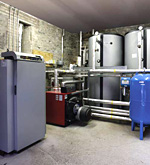Reasons for changing to woodfuel
The need to replace old, often problematic boilers at each
property at a time when the estate was developing its own wood fuel
harvesting operation, meant that woodfuel was the obvious solution
when it came to choosing a new heating system.
There are clear financial benefits in terms of greatly reduced
and stable fuel costs. In addition, the improved woodland
management should raise the quality and future productivity of the
woodlands, offering further business opportunities.
System features and benefits

Gelston uses a wood fuel district heating
scheme where heat is distributed via an underground pipe
network from a single centralised boiler to each of the properties.
As hot water travels round the network, it is drawn off to heat
each property. District heating schemes have a number of
advantages:
- Cost effective: a single boiler, boiler house and fuel store
can supply many properties
- Highly energy efficient due to heat recovery system
- Delivered heat to each user is measurable and accurate, and
allows individual billing
The new system is much more efficient and reliable than the
previous old boilers. It is loaded and fired on a daily basis.
After two years of continuous operation the owners are very
happy with the development of their own fuel supply chain. The
efficiency, both financial and environmental, continues to improve
as prices on world energy markets increase.
Wood fuel supply
The estate's own hardwood logs are being processed, stored and
delivered from estate woodland resources less than a mile away.
Installation issues
The wood fuel heating system was retro-fitted into seven old
stone buildings and required a complete redesign of the previous
system, including replacement of four oil boilers.
The other properties were previously heated by electric storage
heaters and required new wet heat distribution networks to be
installed.
The boiler was installed in the former coach house which has
listed building status, so a sympathetic and patient design process
was required, especially for the flue.
Lessons learned
- If using your own resources, you need to plan your fuel supply
one year ahead
- Get training from your installer so that you clearly understand
the controls of your system
- Adjust the user definable parameters to suit the site
conditions
Facts and figures
Note: figures are approximate
| Building |
| Heated area |
840 m2 |
| Heated volume |
2,000 m3 |
| Fabric |
Stone |
| Heating system |
| Boiler manufacturer |
Fröling |
| Maximum boiler output |
70 kW |
| Fuel type |
Logs |
| Fuel specification |
- Moisture content: <30% (M30)
- Log size: 500 mm split lengths
|
| Back-up/top-up system |
Oil boiler (100 kW) |
| Fuel consumption, costs and savings |
| Weekly woodfuel use |
2-3 tonnes |
| Annual CO2 savings |
58 tonnes |
| Wood fuel cost |
Approx £4,000 (estimated cost of staff to process
woodfuel) |
| Annual fuel cost saving at 2008/09 prices |
£6,000 |
| Payback period |
12 years (inc. cost of radiator system) |
| Installation cost and funding |
| Boiler system |
£42,000 |
| Funding source |
Scottish Biomass Heat Scheme |
| Funding support rate |
50% of additional costs of woodfuel system |